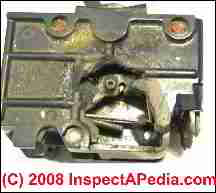 Circuit Breaker Reliability Tests
Circuit Breaker Reliability Tests
Standards, Procedures & Test Results for Residential Circuit Breakers
- POST a QUESTION or COMMENT about residential circuit breaker testing standards, procedures, results
This article describes the safety & reliability of some brands of residential circuit breakers, circuit breaker testing according to UL-489 and breaker failures across several brands including FPE, Murray, Crouse-Hinds, BullDog Pushmatic.
InspectAPedia tolerates no conflicts of interest. We have no relationship with advertisers, products, or services discussed at this website.
Standards, UL-489 Test Procedures, Test Results for Some Residential Circuit Breakers
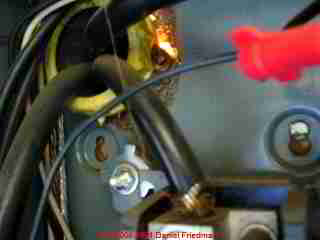 Dr. Jess Aronstein & Daniel Friedman
Dr. Jess Aronstein & Daniel Friedman
In 1985 as I (D Friedman) was leaving an ASHI home inspectors association meeting in Elmsford, New York, Tom Byrne, an old-timer gave me a tip:
"Watch out for those FPE Panels", Tom said, "They're no damn good."
"Could you be a bit more specific? What's wrong with them?" I asked.
"They're just no damn good. Warn people!" Tom grinned.
Until about 2011, electrical engineers, fire researchers, electricians, electrical inspectors and home inspectors in North America generally thought that there was one particularly-unreliable brand of circuit breaker installed in U.S. homes: FPE Stab-Lok circuit breakers and electrical panels installed over many decades.
[Click to enlarge any image]
These FPE or FPE-design circuit breakers sold under several brand names were notorious for failing to trip in response to an over-current.
See FPE HAZARD ARTICLES, STUDIES and see this SUMMARY of the FPE Stab-Lok® HAZARD for details.
The failure of a circuit breaker to trip when it should, that is to open or drop power to the electrical circuit it is supposed to be protecting risks fire and shock injury to buildings and their occupants.
Also unsafe if slightly more subtle, two-pole FPE breakers frequently jam internally so that even if the circuit breaker is switched to its OFF position, it may remain ON internally - risking a shocking surprise for someone who thinks she has turned off electrical power to the circuit before working on it.
No-Trip Failures of Older & "New" FEP FPE and UBI-FPE Circuit Breakers
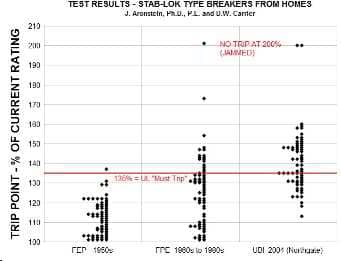 Shown in the graph above/left, no-trip circuit breaker failure results for three FPE Stab-Lok® type circuit breakers tested by Aronstein & Lowry and reported by IEEE in 2011.
Shown in the graph above/left, no-trip circuit breaker failure results for three FPE Stab-Lok® type circuit breakers tested by Aronstein & Lowry and reported by IEEE in 2011.
[Click to enlarge any image]
Those authors tested FEP breakers from the 1950's, FPE breakers produced from about 1960 to 1980, and UBI-brand Chinese-made "new replacement" circuit breakers for FPE panels collected from a condominium complex in 2004.
Aronstein & Lowry, in estimating fire losses associated with circuit breaker malfunction in the United states document the high failure rate of FPE circuit breakers (failure to trip in response to overcurrent when tested in accordance with UL Standard 489) comment in their paper's conclusion:
Incredibly, although factual information and test data as to the defective performance of FPE Stab-Lok® breakers has been available for at least a quarter of a century to those who would seek it out, there is no nationally respected electrical safety organization or authority that has taken the initiative to suggest publicly and in plain language that they be changed in the interest of fire safety. - Aronstein & Lowry (2011)
Failure Rates of Older Bryant, Frank Adams, Bulldog Pushmatic, Murray, Crouse Hinds Circuit Breakers
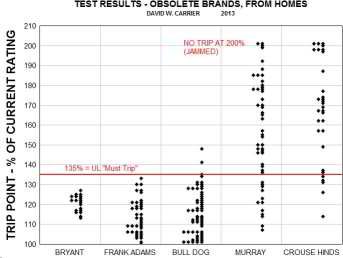
Shown in the graph at above/left: Obsolete Circuit Breaker Testing by D. Carrier (2013) - un-published.
A common UL-489 test of circuit breakers exposes the breaker to 135% of its rated current. This is the "must-trip" current: at this level the circuit breaker switch must open to shut down the circuit. (Lower red line in the graph shown here).
For example, to test a 20-A circuit breaker at 135% of rated current we'd expose the breaker to a load of 27 Amps (1.35 x 20).
A second common circuit breaker test for breakers that did not open at 135% of rated current is to expose the breaker to 200% of rated current. In the chart shown here, Murray and Crouse Hinds breakers not only failed to open at 135% of rated current, they jammed there or at higher current.
A "jammed" circuit breaker will not open to turn off the circuit at any level of overcurrent whatsoever.
Beginning in 2011 and using both equipment and procedures provided by Jess Aronstein, an electrical engineer with long experience in electrical system failure research and testing, David Carrier, an electrical engineer in Poughkeepsie, New York, began testing additional brands of what he considered "obsolete" electrical circuit breaker brands collected from various homes.
While the total number of circuit breakers tested by Carrier remained a comparatively small sample (n=???), the results were striking, as you can see in the graph of test results shown just below.
Although the number of tests was limited, the pattern of test results is sufficiently clear and dramatic as to provide a compelling observation:
some electrical circuit breaker manufacturers, such as Bryant, quite apparently have got a sufficient grip on manufacturing, testing, and listing procedures for their products that the product performance in the field is very consistent, with virtually no failures-to-trip observed.
Yet other electrical circuit breaker manufacturers (Frank Adams, Bulldog Pushmatic, Murray, Crouse Hinds) produced circuit breakers whose performance, when independent tests were performed, showed dramatic failure rates.
We deliberately exclude from this data and from tests, electrical panels and circuit breakers that have been exposed to abnormal conditions such as flooding, wetting, or fires from other causes.
Conclusions
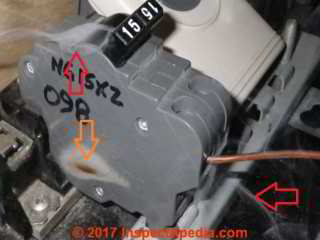 What should consumers, electricians, and building inspectors or home inspectors make of this situation?
What should consumers, electricians, and building inspectors or home inspectors make of this situation?
Electricians who install electrical panels and circuit breakers, consumers who use them, and inspectors who examine them, can be expected to believe that in normal field situations,a circuit breaker that is exposed to over-current conditions as described in the most-widely-applied test standard in the U.S. (UL-489), the breaker will trip when it should. People expect that circuit breaker failures will occur both rarely and randomly.
What needs to be clearly stated is the user / purchaser expectation that the product on the market meets or exceeds the UL489 requirements, as certified by the listing label.
Making the picture a bit muddier is the fact that there are different degrees of severity of failure.
A few % over the limit calibration failure is not very serious, but a breaker that won't trip at all is a different level of hazard. - J. Aronstein to D. Friedman, private email, 2017/03/15
Photo above: a UBI-brand replacement FPE Stab-Lok circuit breaker smokes without tripping off under testing described at UBI FPE CIRCUIT BREAKER TEST RESULTS.
Ongoing tests of this contemporary replacement circuit breaker have to date found an overall failure rate of 45%. (n=265 in March 2017).
We do not have an electrical industry number telling us the expected percent of failure-to-trip problems among circuit breakers, but as Aronstein explains, consumers do expect that UL-listed circuit breakers, in normal, properly-functioning equipment that has not been damaged by some outside force (leaks, corrosion, fire, abuse, modification) will behave like this:
- The circuit breaker will fail to trip at 135% of rated load only in extremely rare cases
- Failures of circuit breakers to trip off when they should will be randomly distributed across the population of installed equipment
That is not the case.
Instead, the graphs and test data shown above and cited in the research below indicate that for some brands there are both a high no-trip failure rate and a sufficiently-consistent failure occurrence even among a relatively-small sample, that there is compelling evidence that the equipment is both unreliable and unsafe.
In our OPINION, changes in the electrical testing procedures permitted under UL-489 (UL now NRTL) underlies a deterioration in the quality of some electrical circuit breakers on the market.
Yhe fox is watching the henhouse - that is, manufacturers are permitted to conduct their own testing, monitored by a third party listing agency who in turn provides no test result information to the public. Some of them do a great job. Some, quite obviously, are not doing so well. In the Aronstein/Lowry data shown above, and as we explain in the bulleted items below,
- FEP - UL did their own sampling and testing. (FEP = Federal Electric Products)
- FPE - UL monitored FPE's testing, factory in USA
- UBI - ETL monitors testing, factory in China
In the United States, there is no person, no government agency, and no industry organization that has a stated responsibility to take action on this matter on behalf of public safety. - view of the authors
Conversely, the data also indicates that some circuit breaker manufacturers are producing a very reliable product.
The Bryant sample set comes from 5 different sources in four cities (Dallas, Armonk, Poughkeepsie, and Kingston). They are not from one lot and not likely to be from the same year.
You are right that [the sample set] small in number, but a tight distribution like this in a sample from 5 sources is a very strong indication that Bryant knew how to calibrate their breakers and their breakers do not deteriorate with age. - J. Aronstein to D. Friedman, private email, 2017/03/17
Research
- FRANK ADAM ELECTRICAL PANELS
- FPE FAILURE FIRE PHOTOS and FPE FAILURE FIELD REPORTS describe FPE failures and fires, where more than 170 field failure reports are described.
- CORROSION in ELECTRICAL PANELS we give an example of those "abnormal" conditions, noting at the same time that there may be more-frequent wetting and corrosion problems in electrical panels than the manufacturers originally imagined.]
- Aronstein, Jess 1, (Life Senior Member, IEEE), & David W. Carrier 2 MOLDED CASE CIRCUIT BREAKERS - SOME HOLES IN THE ELECTRICAL SAFETY NET [PDF]
Received December 4, 2017, accepted January 24, 2018, date of publication February 7, 2018, date of current version March 15, 2018. Digital Object Identifier 10.1109/ACCESS.2018.2803298
1 Consulting Engineer, Schenectady, NY 12309, USA, 2 SUNY Dutchess Community College, Poughkeepsie, NY 12601, USA, Corresponding author: Jesse Aronstein (AronsteinJ@verizon.net)
This paper is also available at no charge at the IEEE Explore website. It can be accessed for online reading at: http://ieeexplore.ieee.org/document/8283732/ - Aronstein, Jesse, and Richard Lowry. "Estimating fire losses associated with circuit breaker malfunction." In Electrical Safety Workshop (ESW), 2011 IEEE IAS, pp. 1-7. IEEE, 2011.
Abstract:
A method is presented for connecting small branch circuit breaker functional test data to statistical fire loss data. Test results are presented for field samples of a particular line of circuit breakers that have an abnormally high defect level.
The test results are then utilized in combination with available electrical fire statistics to estimate the annual number of fires and consequent injuries, deaths, and monetary loss associated with the defective breakers. An estimate is then made of the reduction of injury and loss that can be achieved by encouraging replacement of the defective breakers.
The role of the electrical safety community in promoting replacement of the defective breakers is discussed.
This research paper concludes that
FPE Stab-Lok® is a line of breakers with an unacceptably high rate of defective performance. It is presently installed in about 17 million homes across the country as well as in countless additional buildings of other types.
The estimated 2,829 residential electrical fires per year nation-wide associated with the defective breakers amounts to about one fire per year for every 6,000 FPE Stab-Lok® equipped homes.
This is about 2.5% of the annually reported residential electrical fires in this country. [i.e. in The United States - Ed.] - "Failure Analysis of Residential Circuit Breaker Panel", Wright-Malta Corp., (by J. Aronstein, for U.S. Consumer product Safety Commission, Project #CPSC-C-81-1455), May 20, 1982 (Contains failure analysis of FPE Stab-Lok® panel that ignited, due to failure of buss-bar interconnections in the backside of
the panel.) - . "Final Report: Calibration and Condition Tests of Molded Case Circuit Breakers", Wright-Malta Corp.,
(by J. Aronstein, for U.S. Consumer product Safety Commission, Project #CPSC-C-81-1429), December
30, 1982 (Extensive calibration and functional testing of FPE breakers. Substantial percent failures
to trip on overload.). - "Status Report - Evaluation of Residential Molded Case Circuit Breakers", Wright-Malta Corp., (by J. Aronstein, for U.S. Consumer product Safety Commission, Project #CPSC-C-81-1455), August 10, 1982 (Contains analysis of mechanism of failure of FPE two-pole Stab-Lok® breakers.)
- "Phase II Report, Evaluation of Residential Molded Case Circuit Breakers", Wright-Malta Corp., (by J. Aronstein, for U.S. Consumer product Safety Commission, Project #CPSC-C-81-1455), March 10, 1984 (Contains experimental analysis of materials, construction, and performance of molded case circuit breakers, including FPE.)
- and citing: Partial Summary Judgment decision dated 8/15/02 by Judge Bryan D. Garruto, J.S.C., Superior Court of New Jersey, Law Division: Middlesex County, Docket No. L-2904-97
- Babrauskas, Vytenis. "HOW DO ELECTRICAL WIRING FAULTS LEAD to STRUCTURE IGNITIONS" [PDF file downloaded 2017/03/15] In Proc. Fire and Materials 2001 Conf, pp. 39-51. 2001.
- Billinton, Roy, Ronald Norman Allan, and Ronald N. Allan. Reliability evaluation of power systems. Vol. 2. New York: Plenum press, 1984.
- Braun, A. "Validity of Unit Testing on Circuit-Breakers Exhibiting Statistically Varying Breaking Capacity." Power Apparatus and Systems, IEEE Transactions on 3 (1972): 791-797.
- Dehghanian, Payman, and Mladen Kezunovic. "Cost/benefit analysis for circuit breaker maintenance planning and scheduling." In North American Power Symposium (NAPS), 2013, pp. 1-6. IEEE, 2013.
- Emanuel, A. E., and John W. Dougherty. "Sensitive ground fault interrupter performance in the presence of direct current." Power Delivery, IEEE Transactions on 1, no. 1 (1986): 111-117.
- Fu, Xing, Xiaorui Wang, and Charles Lefurgy. "How much power oversubscription is safe and allowed in data centers." In Proceedings of the 8th ACM international conference on Autonomic computing, pp. 21-30. ACM, 2011.
- Gregory, George D., and Gary W. Scott. "The arc-fault circuit interrupter, an emerging product." In Industrial and Commercial Power Systems Technical Conference, 1998 IEEE, pp. 48-55. IEEE, 1998.
- Hall, William M., Gary Donner, Banafsheh Kalhori, George D. Gregory, John Gardner, and Matt Samojeden. "A user guide to the selection, application, testing and life expectancy of molded case circuit breakers." In Petroleum and Chemical Industry Conference, 1995. Record of Conference Papers., Industry Applications Society 42nd Annual, pp. 65-75. IEEE, 1995.
- Heunis, Schalk W., and Ron Herman. "A probabilistic model for residential consumer loads." Power Systems, IEEE Transactions on 17, no. 3 (2002): 621-625.
- IEEE Standards Collection, C37 -- Circuit Breakers, Switchgear, Substations, and Fuses, 1995 Edition, The Institute for Electrical and Electronics Engineers, Inc. New York, NY: IEEE
- Kimball, Jonathan, and Jordan Henry. "Compatibility between GFCI breakers and household adjustable speed drives." In Energy Conversion Congress and Exposition, 2009. ECCE 2009. IEEE, pp. 517-520. IEEE, 2009.
- Koty, Ken, "Testing and Exercising Branch Circuit Breakers", web page article, Website: http://www.pducables.com/ Email: kkoty@pducables.com, retrieved 3 April 2015, original source http://www.pducables.com/TestingandExercisingBranchCircuitBreakers.htm
- Lee, Jaebok, Sughun Chang, Sungho Myung, and Yuengue Cho. "Transient false tripping characteristic analysis of ground fault circuit interrupter." In Power System Technology, 2004. PowerCon 2004. 2004 International Conference on, vol. 1, pp. 522-526. IEEE, 2004.
- Lindquist, T. M., Lina Bertling, and Roland Eriksson. "Circuit breaker failure data and reliability modelling." IET generation, transmission & distribution 2, no. 6 (2008): 813-820.
- Lippert, Kevin J., and T. Domitrovich. "AFCIs-From a standards perspective." In Electrical Safety Workshop (ESW), 2013 IEEE IAS, pp. 57-61. IEEE, 2013.
- Mili, Lamine, Q. Qiu, and Arun G. Phadke. "Risk assessment of catastrophic failures in electric power systems." International Journal of Critical Infrastructures 1, no. 1 (2004): 38-63.
- Natti, Satish, Panida Jirutitijaroen, Mladen Kezunovic, and Chanan Singh. "Circuit breaker and transformer inspection and maintenance: probabilistic models." In Probabilistic Methods Applied to Power Systems, 2004 International Conference on, pp. 1003-1008. IEEE, 2004.
- NEMA Standards Publication AB 4, National Electrical Manufacturers Association, Washington DC 20037: NEMA
- Pahl, Birger, Thomas J. Schöpf, Xin Zhou, and Engelbert Hetzmannseder. "Arc faults in residential electrical systems." VDE-Fachbericht-Kontaktverhalten und Schalten (2009).
- Rusek, Bartosz, Gerd Balzer, Martin Holstein, and Max-Steffen Claessens. "Timings of high voltage circuit-breaker." Electric Power Systems Research 78, no. 12 (2008): 2011-2016.
- Schlabbach, Jiirgen, and T. Berka. "Reliability-centred maintenance of MV circuit-breakers." In Power Tech Proceedings, 2001 IEEE Porto, vol. 4, pp. 5-pp. IEEE, 2001.
- Schneider Electric, "ANSI® C37 Standard and UL® 489 Standard Comparison", Schneider Electric, Data Bulletin No. 0613DB9902, June 1999, Cedar Rapids IA, USA, retrieved 3 Apr 2015, original source: http://static.schneider-electric.us/docs/Circuit%20Protection
/Insulated%20Case%20Circuit%20Breakers/0613DB9902.pdf - Sprague, Michael, J., "Service-Life Evaluations of Low-Voltage Power Circuit Breakes and Molded-Case Circuit Breakers", Michael J Sprague
Member, IEEE
Cutler-Hammer, Inc.
130 Commonwealth Drive
Warrendale, PA 15086
USA, retrieved 3 April 2015, original source: http://www.eaton.eu/ecm/groups/public/@pub
/@electrical/documents/content/ct_129977.pdf - Steel, J. G. "Statistical model for single-unit and multiunit circuit breakers." In Proceedings of the Institution of Electrical Engineers, vol. 119, no. 4, pp. 488-492. IET Digital Library, 1972.
- Steel, J. G., and D. T. Swift-Hook. "Statistics of circuit-breaker performance." Electrical Engineers, Proceedings of the Institution of 117, no. 7 (1970): 1337-1345.
- UL 67, UL Standard for Safety for Panelboards, Underwriters Laboratories Inc., Northbrook IL 60062: UL
- UL 489, "Molded-Case Circuit Breakers, Molded-Case Switches, and Circuit Breaker Enclosures", Regulatory Services Department UL 333 Pfingsten Road Northbrook, IL 60062 ulregulatoryservices@us.ul.com 800-595-9844, retrieved 3 April 2015, original source: http://ulstandardsinfonet.ul.com/scopes/scopes.asp?fn=0489.html
- UL, "Molded Case Circuit Breakers", (2012) Regulatory Services Department
UL
333 Pfingsten Road
Northbrook, IL 60062
ulregulatoryservices@us.ul.com
800-595-9844, retrieved 3 April 2015, original source: https://www.ul.com/global/documents/offerings/perspectives/regulators/
electrical/newsletters/MoldedCaseCircuitBreakersMG.pdf - Wiermann, T.E., Rasmuson, D.M., Stockton, N.B., "Common-Cause Failure Event Insights: Circuit Breakers", Idaho National Engineering & Environmental Laboratory, U.S. Nuclear Regulatory Commission, Office of Nuclear Regulatory Research, Washington DC 20555, NUREG.CR-6819, Vol., 4, INEEL/EXT-99-00613, retrieved 3 April 2015, original source: http://pbadupws.nrc.gov/docs/ML0317/ML031710861.pdf
- Yacout, A. M., R. N. Hill, L. Van Den Durpel, P. J. Finck, E. A. Schneider, C. G. Bathke, and J. S. Herring. "Dynamic analysis of the AFCI scenarios." Growth 400000 (2004): 500000.
and can be downloaded directly from IEEE at http://ieeexplore.ieee.org/stamp/stamp.jsp?tp=&arnumber=8283732
The Authors:
- Dr. Jess Aronstein, protune@aol.com is a research consultant and an electrical engineer in Schenectady, NY. Dr. Aronstein provides forensic engineering services and independent laboratory testing for various agencies.
Dr. Aronstein has published widely on and has designed and conducted tests on aluminum wiring failures, Federal Pacific Stab-Lok electrical equipment, and numerous electrical products and hazards.
See ALUMINUM WIRING BIBLIOGRAPHY and FPE HAZARD ARTICLES, STUDIES,and BACK-WIRED ELECTRICAL DEVICES and also ZINSCO FAILURE REPORTS for examples of his contributions reported at InspectApedia.com - Daniel Friedman - is the publisher & editor of InspectAPedia.com®
- Daniel Friedman's Resume - credentials, education, experience, professional memberships
- Daniel Friedman's CV - publications, classes, seminars, conference presentations
Contributor:
- David W. Carrier, electrical engineer, Poughkeepsie, NY 12603 845-430-7527 davidwcarrier@earthlink.net. Mr. Carrier has conducted failures testing on electrical circuit breakers and panel asssemblies, supplementing Dr. Jes Aronstein's research into FPE and other circuit breaker performance of other brands such as GE, ITE, Murray, Siemens, Bulldog Pushmatic, Zinsco.
...
Continue reading at CIRCUIT BREAKER FAILURE RATES - research on the performance of various circuit breaker brands sold in North America or select a topic from the closely-related articles below, or see the complete ARTICLE INDEX.
Or see these
Recommended Articles
- BLOWN FUSE REPLACEMENT
- CIRCUIT BREAKER RESET STEPS
- CHALLENGER ELECTRIC PANELS
- CIRCUIT BREAKERS RE-CONDITIONED USED
- FPE HAZARD REPORT - 2017 [PDF]
- FPE Stab-Lok® : FIRES WAITING TO HAPPEN
- FRANK ADAM ELECTRICAL PANELS
- MURRAY CIRCUIT BREAKER HAZARDS
- MURRAY SIEMENS Recall
- PRIVATE BRAND/ EMI FPE PANELS
- PUSHMATIC - BULLDOG PANELS
- TEST MAIN BREAKERS & FUSES
- UBI FPE CIRCUIT BREAKER TEST RESULTS
- ZINSCO CIRCUIT BREAKER TEST REPORT
Suggested citation for this web page
CIRCUIT BREAKER RELIABILITY TESTS at InspectApedia.com - online encyclopedia of building & environmental inspection, testing, diagnosis, repair, & problem prevention advice.
Or see this
INDEX to RELATED ARTICLES: ARTICLE INDEX to ELECTRICAL INSPECTION & TESTING
Or use the SEARCH BOX found below to Ask a Question or Search InspectApedia
Ask a Question or Search InspectApedia
Try the search box just below, or if you prefer, post a question or comment in the Comments box below and we will respond promptly.
Search the InspectApedia website
Note: appearance of your Comment below may be delayed: if your comment contains an image, photograph, web link, or text that looks to the software as if it might be a web link, your posting will appear after it has been approved by a moderator. Apologies for the delay.
Only one image can be added per comment but you can post as many comments, and therefore images, as you like.
You will not receive a notification when a response to your question has been posted.
Please bookmark this page to make it easy for you to check back for our response.
Our Comment Box is provided by Countable Web Productions countable.ca
Citations & References
In addition to any citations in the article above, a full list is available on request.
- In addition to citations & references found in this article, see the research citations given at the end of the related articles found at our suggested
CONTINUE READING or RECOMMENDED ARTICLES.
- Carson, Dunlop & Associates Ltd., 120 Carlton Street Suite 407, Toronto ON M5A 4K2. Tel: (416) 964-9415 1-800-268-7070 Email: info@carsondunlop.com. Alan Carson is a past president of ASHI, the American Society of Home Inspectors.
Thanks to Alan Carson and Bob Dunlop, for permission for InspectAPedia to use text excerpts from The HOME REFERENCE BOOK - the Encyclopedia of Homes and to use illustrations from The ILLUSTRATED HOME .
Carson Dunlop Associates provides extensive home inspection education and report writing material. In gratitude we provide links to tsome Carson Dunlop Associates products and services.

